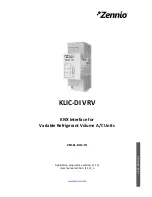
20 Gear Drive, Plymouth Ind. Park, Terryville, CT 06786
Tel: (860) 585-1254 Fax: (860) 584-1973 http://www.amci.com
67
REFERENCE 7
C
OMMAND
M
ODE
D
ATA
F
ORMAT
Data Format
A Networked Driver requires twenty bytes of Output Data as well as twenty bytes of Input Data. In
EtherNet/IP applications that use a non-generic EDS file, these 20 bytes will be a mixture of single and dou-
ble integers. In EtherNet/IP applications that do not use an EDS file, or a generic EDS file, the Networked
Driver is added to the network as a generic device. In this case the data is represented as ten 16-bit (single)
integers. This ten word format is also used in Modbus TCP and PROFINET applications.
Sixteen bit integers support a range of values from -32,768 to 32,767 or 0 to 65,535. When issuing commands
to the Networked Driver, there are several parameters that are larger than sixteen bits. These parameters are:
Target Position
Programmed Speed
Stopping Distance
Minimum Registration Move Distance
Position Preset Value
Encoder Preset Value
Likewise, when reading data back from a Networked Driver while it is in Command Mode, there are values
that are larger than sixteen bits. These data values are:
Motor Position
Encoder Position
Captured Encoder Position
By default, these thirty-two bit parameters and data values are written to and read from the Networked Driver
using the multi-word format described below. When configuring the Networked Driver, it is possible to pro-
gram it to use a 32-bit double integer format instead of the custom format shown below.
There are three configuration bits that control the data format when the Networked Driver is in command
mode. The
Binary_Output_Format Bit,
controls the format of the programmable parameters written to the
Networked Driver when issuing commands. The
Binary_Input_Format Bit,
controls the format of the data
values written to the host controller by the Networked Driver. When either of these parameters are set to their
32-bit signed integer format settings, the Data_Endian bit determines if the 32-bit values are stored and trans-
mitted least significant bits first or most significant bits first. Examples of the formats are given below.
Table R7.1 Position Data Format Examples
This chapter covers the formats of the Network Output Data used to command the
SD17060E2 or SD31045E2 as well as the formats of the Network Input Data that con-
tains the responses from the device. The Networked Driver requires ten 16-bit words
(20 bytes) for Output Data as well as ten 16-bit words for Input Data. Note that the Net-
worked Driver, when in its factory default state, will power up in Configuration Mode.
The Configuration Mode data format is described in the previous chapter.
Multi-Word Format
32 bit Signed Integer
Little Endian Format
(EtherNet/IP)
32 bit Signed Integer
Big Endian Format
(Modbus TCP specification)
Value
First Word
Second Word
First Word
Second Word
First Word
Second Word
12
0
12
16#000C
16#0000
16#0000
16#000C
-12
0
-12
16#FFF4
16#FFFF
16#FFFF
16#FFF4
1,234,567
1,234
567
16#D687
16#0012
16#0012
16#D687
-7,654,321
-7,654
-321
16#344F
16#FF8B
16#FF8B
16#344F















































